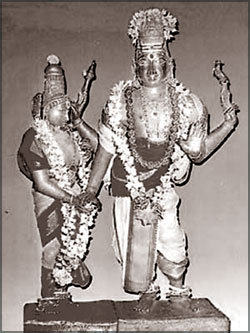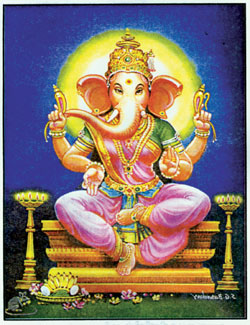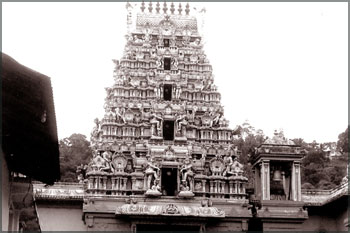|
Hinduism
Abirami Pattar’s Festival in Thirukadiyur
Chelvatamby Maniccavasagar
Every year during the Tamil Month of Thai (January) in New Moon Day (Amavasai)
‘Abirami Pattar’ festival is celebrated in temples in Sri Lanka and at
‘Thirukadiyur’ in South India.
|

Thirukadiyur Abirami Pattar |
In fact, many years ago in South India there was one devotee of
Goddess Abirami called Subramanian in Thiru Kadaiyur, Tamil Nadu. He had
deep devotion towards the Mother Goddess Abirami, indulging in
performing poojas (U) showering of flowers at the feet of Goddess
Abirami.
One day King Saraboji, visited this temple when devotee Subramanian
was meditating.
The King was provoked seeing Subramanian’s ignorance about his
arrival.
The King asked who that man was. One of the devotees told the king
that he was mad thinking the other women as Amman and used to shower
flowers on them. But, the Chief priest of this temple told, that he was
a deep devotee of Goddess Abirami.
The King wanted to test who he was ! So, King Saroboji looked at
Subramanian and asked whether today is New Moon Day (Amavasai) or Full
Moon Day. At that time Subramanian was in eternal bliss of Goddess
Abirami enjoying her beautiful face surrounded with thousands of
sunlights. So, Subramanian answered the King, that the day was ‘Full
Moon Day’ which was actually ‘New Moon Day’ (Amavasai).
The King Saroboji got angry and ordered to push Subramanian into the
burning fire at evening if the Moon did not appear. Thereafter, the
Kings’ Army awakened Subramanian and called him to come with them, to
undergo the punishment.
Returning to his consciousness, Subramanian realised that “Goddess
Abirami” alone made him to say, it was a ‘Full Moon Day’ when it was
really a New Moon Day (Amavasai).
Burning fire, with rays beneath him and Subramanian was on top, inch
by inch mooving down by the forces.
Realizing that ‘Amman Abirami’ alone can save him, he started singing
100 songs as Abirami (the so called Abirami Anthathi) and prayed Her to
come to his rescue.
While singing the 79th song stating that Her merciful eyes have got
super power and she is the ocean of blessings with no limits.
Immediately ‘Annai Abirami’ appeared before him and threw Her ‘Ear ring”
in the sky which appeared as Moon for full night.
Seeing this, the being Saroboji was immensely pleased on
Subramanian’s devotion and honoured him by calling him ‘Abirami Pattar’
and the king himself became a disciple of Abirami Pattar.
The king, not only gave the name Abirami Pattar, but donated lands,
gold and also a surname ‘Barathi’ for Abirami Pattars’ generations.
In fact, ‘Abirami Pattar’ wrote the following: - ‘Abirami Anthathi,’
‘Kallavaranar Pathigam,’ ‘Amirtha Kadeswarar Pathigam’, ‘Kala Samhara
Moorthy Pathigam’, ‘Murugu Venba’, and Abirami ‘Ammai Pathigam’.
Indeed, what we come to know from ‘Abirami Pattar’s’ life is that
‘God alone is all providing, pervading super power and immortal. All the
worldly creatures are not perennial.’ If you are really interested to
see God, you are supposed to do meditation and prayers to receive His
Divine Blessings.
A Religious Journal from Yaalpaanam
K. S. Sivakumaran
Since 1889 a Hindu journal in Thamil and English is continuously
being published in Yaalpaanam (In English the foreigners called the city
Jaffna.
Anachronistically this outmoded name is continued even after the
country’s independence). The name of the journal in Thamil is Indu
Saathanam and in English - Hindu Organ. This is edited by S.
Shivasaravanabavan (well-known Lankan writer in Thamil - a.k.a) and
published by the Saiva Paripalana Sabai -450, KKS Road Yaalpaanam. Their
phone number is 021 2227678. e-mail:[email protected] The first
issue for the current year reached us a few days ago. For those of us
who would like to know more about Hinduism in general and Saiva
Siddhantham in particular, such journals could also add more knowledge
and information.

The 16 page publication with two colour photos contains interesting
and educative pieces of writing. For instance if you would like to know
something about Hindu temple worship, there is an authentic essay by Dr.
Sivathiru K. Vytheeswara Kurukkal which clarifies why worship in the
temples is necessary.
Felt experience matters in any religion. The Almighty may not be
visible to all. His grace could be only felt when the devotee surrenders
himself to God and seek blessings for the soul to merge with Him or Her
is a primary revelation for the Hindus. God speaks through people whom
he directs to communicate with others who believe in God. One such
incident was recounted by a Thamil scholar from Thamilnadu in India.
Prof. A. S. Gnanasambanthan.
Excerpts in the form of re-writing by the creative writer are
published. One must read this writing for the message it transmits. What
the reader also learns of a great saint in Yaalpaanam named Yogar Swami.
Siva. Saranan (nom-de-plume of the editor) elucidates lines from the
Saiva Saints (Naayanmaar) to show the importance of obtaining the divine
grace. Similarly there is another short article on reciting the
Thevaarams (Holy Hymns) with true understanding to beg for divine love.
What is great about rain water is befittingly included.
The editorial titled “Living in Comfort but not with Happiness” is
self-explanatory.
The republication of No 23 of a series of articles written by Prof R
Kumaravadivel in 2001 on the origin and development of the Saiva
Paripalana Sabai is of historical importance.
A page is devoted to the children to understand Saivaism which
includes a Q & A clarification of Vinayagar.
Former Deputy Principal of Yaalpaanam Hindu Ladies college, Pushpa
Selvanayagam recalls how the Saint Thirugnanasambanthar revived Hinduism
when Jainism and Buddhism held sway in Thamilnadu during the Pallava
Period in South Indian History.
The late N. Muthiah who edited another religious journal called
Aathma Jothi wrote an article 22 years ago on Hindu Thamilians in
Indonesia.
This is reproduced in the current issue of the journal under review.
This article would be immensely interesting to those of us who are
uninitiated on the subject.
The article in English ‘Affirms that Saiva Siddhantham is the unique
philosophy of the Thamil Hindus and has its roots in our classical
Thamil Literature’. Emeritus professor A. Sanmugadas has written this
explanatory article. His spouse Dr. Manonmani Sanmugadas relates the
consonance between religion and nature.
All in all, I benefitted reading this journal. I am sure readers of
the spiritual kind would appreciate the contents of Indu Saathanam.
[email protected]
Hindu beliefs
Hinduism embraces a great diversity of beliefs, a fact that can be
initially confusing to westerners accustomed to creeds, confessions, and
carefully-worded belief statements. One can believe a wide variety of
things about God, the universe and the path to liberation and still be
considered a Hindu.
This attitude towards religious belief has made Hinduism one of the
more open-minded religions when it comes to evaluating other faiths.
Probably the most well-known Hindu saying about religion is: “Truth is
one; sages call it by different names.”
However, there are some beliefs common to nearly all forms of
Hinduism that can be identified, and these basic beliefs are generally
regarded as boundaries outside of which lies either heresy or non-Hindu
religion.
These fundamental Hindu beliefs include: the authority of the Vedas
(the oldest Indian sacred texts) and the Brahmans (priests); the
existence of an enduring soul that transmigrates from one body to
another at death (reincarnation); and the law of karma that determines
one’s destiny both in this life and the next.
The ultimate goal of all Hindus is release (moksha) from the cycle of
rebirth (samsara). For those of a devotional bent, this means being in
God’s presence, while those of a philosophical persuasion look forward
to uniting with God as a drop of rain merges with the sea.
Authority of the Vedas and Brahmans
The authority of the ancient scriptures known as the Vedas as well as
that of the priests known as the Brahmans are two concepts that are
fundamental to Hinduism and differentiate the faith from Buddhism and
Jainism.
Karma
The Sanskirt word karma means “actions” and refers to the fundamental
Hindu principle that one’s moral actions have unavoidable and automatic
effects on one’s fortunes in this life and condition of rebirth in the
next.
Purpose of Life
In Hinduism, there is not just one purpose of human life, but four:
Dharma - fulfilling one’s purpose; Artha - prosperity; Kama - desire,
sexuality, enjoyment; and Moksha - enlightenment.
Philosophy in Hinduism
Thilaka V. Wijeyaratnam
Saivaism or the religion of Siva worship is the most ancient
religion. Later, there were other deities brought in and Aadishankarar
called it the “Shanmathams” - six religions.
|

300 year old historical Kandy-Katukelle Sri Meenatchi
Somasundareswara Selva Vinayakar Kovil.
Picture by H.M. Mansoor, Kandy Central Group Corr. |
Following Saivaism comes Saktham- worship of mother goddess, then
Vaishanavism - worship of Lord Vishnu, then Ganapathiyam - worship of
God Ganesha, Kaumaram - worship of Lord Murugan and finally Saumaram -
sun worship. So according to Aadishankarar, there are six sects of one
religion which came to be known as Hinduism. However Saivaism is the
foremost of these. There are evidences of mother Goddess in the
excavations at the Indus Valley. This gave rise to Sakthi Worship later.
The philosophy contained in Saivaism is Saiva Sithantham while in
Hinduism it is Vedanta.
In Hinduism we see spiritual ideas. It provides Yoga Sadhana for
people of all ages to suit their age, temperament, capacities, tastes
and their spiritual development and conditions of life. Vedanta says one
can reach God-realization through Yoga Sadhana.
The main thing the Yoga and Vedanta teachers stress on is
self-restraint. Through tapas, renunciation one can control the mind,
and the senses and realise divinity. In fact Hindu Philosophy is also a
way of life.
Everything is controlled by time except the infinite. It has no
beginning, no ending. There is a time for creation (shristy) and a time
for dissolution (pralaya). This is a periodic cycle.
The Truth - The Absolute Truth or Reality does not perish. All others
are subject to decay. As said earlier in Saivaism, the Hindus have
received knowledge of their religion through revelation - the Vedas.
Vedas are the accumulated treasure of spiritual laws, brought by
different people like saints and sages at different times. It is in
fact, the Rishis who discovered these laws.
This reality, this truth - the absolute Truth cannot be pierced by a
sword, the fire cannot burn it, the water cannot melt it, the air cannot
dry it. Hinduism says that every soul is a circle whose circumference is
nowhere, but whose centre is located in the body. It is free, unbounded,
holy, pure and perfect - so says Saivaism too. According to Hinduism the
human soul is eternal and immortal, perfect and infinite and death means
a change of centre from one body to another.
That was what Sri Ramakrishnar told his spiritual wife Saradadevi, “I
am not dead. It’s like discarding one dress and putting on another. Just
know that from this room, I have moved into the other room.”
The Vedas say, that at the head of all the laws and every particle
and force stands one who commands nature itself. What is the nature of
this One called the Paraprahman? He is the formless One the Almighty,
the most merciful God - who is the father, the mother and friend and
giver of strength. He bears the burdens of the Universe.
“When I look at this world, I cannot escape from the feeling that
there is an eternal cosmic mystery behind it.” These words were uttered
by no less a person than the great scientist philosopher Einstein.
It is what he - Einstein - felt that Hinduism refers to as the
Paramathma cosmic energy and the soul in the human body as Jeevathma.
The Jeevathma merging with the Paramathma is the ultimate goal of all
Hindus.
That is the blissful state of Nirvanam - Moksha. The individual soul
(Jeevathma) and the cosmic soul (Paramathma) merge and become one.
Earlier one school of thought proclaimed they are two different entities
- Duvaitham. But Saint Aadi Shankarar declared both are one and
introduced the Athduvaitha Vedanta.
Hinduism is also known as Sanatana Dharma (Eternal Law). The religion
is based on the practice of Dharma - the code of life. Science talks of
the “Bigbang Theory” of creation. Creation in Hinduism is by the
appearance of sound first, light came later.
This sound is called the Nadha Brahmam - Aum - the celestial sound.
The dumbbell in the hand of Lord Siva, when vibrated, produces
dissimilar sounds which are fused together by resonance to create one
sound. This sound is Nadha - the Cosmic Sound of Aum which is the source
of creation.
Finally let us sum up the beliefs of Hinduism thus:
*The all-pervasive Supreme Being is one who is both immanent
(omnipresent) and transcendent (existing apart) - Creator of unmanifest
Reality.
* The universe undergoes endless cycles of creation, preservation and
dissolution.
* Karma by which each individual creates his own destiny by his
thoughts, words and deeds.
* The soul reincarnates evolving through many births until all Karmas
have been resolved and Moksha - spiritual knowledge and liberation from
the cycle of rebirth is attained.
* The divine beings exist in unseen worlds.
* That temple worship, rituals, sacraments and personal devotionals
create a communion with these celestial beings - devas and God.
* A spiritually awakened guru - teacher is essential to know the
Transcendent Absolute.
* In addition to a guru, personal discipline, good conduct,
purification, pilgrimage, self-enquiry and meditation too help to
realise the Truth - the Absolute Truth.
* Practise Ahimsa as the life of every creature is sacred, to be
loved and revered. |





